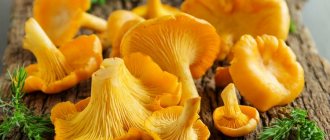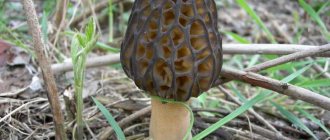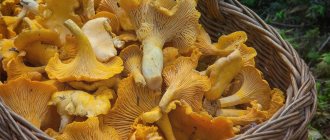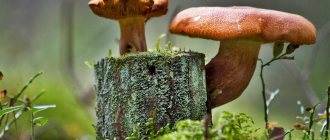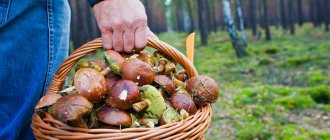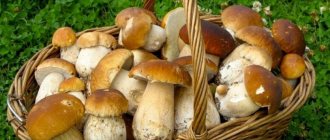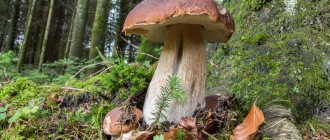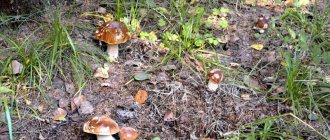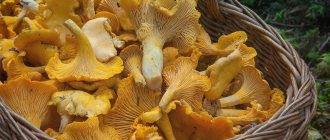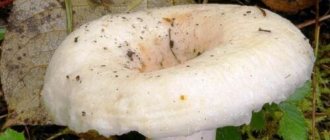Not only avid mushroom pickers, but also amateurs love to collect chanterelles in the Moscow region. These are mushrooms with amazing characteristics.
They do not react at all to rainy or dry weather, so they do not rot or dry out. It is also impossible to find wormy fruiting bodies, but collecting or transporting them is very convenient. Chanterelles do not get crushed, do not break or spoil. The mushroom contains chitinmannose, a strong anthelmintic substance. Therefore, the fruiting bodies are always fresh. However, you should not press down the harvested crop too much; the caps may crumble a little. This will reduce the appearance and quantity of the product. This species is highly valued by housewives for its ability to prepare a whole range of delicious dishes, as well as preparations.
Do chanterelles grow in the Moscow region?
Before you go mushroom hunting, you need to find out where chanterelles grow in the Moscow region. They can be found both in coniferous forests and in mixed or birch forests. If there are similar plantings in the region, then the chance of finding red and tasty mushrooms increases significantly. The Moscow region is rich in forests, so there is a real haven for mushroom pickers here. Almost 40% of the territory is occupied by trees, different species are found, and chanterelles can be found in almost any area. The harvest depends on weather conditions and the number of mushroom pickers who go hunting. There are also empty places. In any case, you need to look for mushrooms in the Moscow region very carefully. Chanterelles prefer the shade of trees, but during the wet period of the year they feel great in clearings. Every year, the growth rate of the fruiting bodies changes slightly, so the mushroom locations may shift slightly.
Where do chanterelles grow in the Moscow region?
An important question for mushroom pickers. It can only be answered with the help of recommendations from experts and reviews from avid mushroom pickers. To help beginners, a map of the Moscow region is even being compiled indicating mushroom places. You can use similar recommendations, just do not collect fruiting bodies near the highways. Main directions:
- Kursk. It includes the stations "Kolkhoznoe" and "Grivno". The easiest way to get there is from Moscow's Kursky Station. There are quite a lot of chanterelles growing to the east of Grivno, so you can get a good harvest.
- Yaroslavskoe. This is the area richest in chanterelles, especially in the area of Pushkino station. There are a lot of them here; mushroom pickers never return without their catch.
- Ryazanskoe. It is recommended to collect chanterelles near Chernaya station. Other places to pick mushrooms in 2022 are Bronnitsa stations, platform 63 km and Faustovo. Once you go 3-4 km from the railway track, you can start searching for fruiting bodies.
- Gorkovskoe. The most distant direction from the capital. Mushroom pickers will be interested in platform 61 km and Fryazino station. At the first stop, chanterelles are found 2 km north or 5 km south of the station.
- Kazanskoe. A destination very rich in mushroom places. It is enough to get to the stations Lukhovitsy, Chernaya, Platforma 63 km and go 1.5-2 km deeper from the railway into the forest to start mushroom hunting.
Important!
Species distribution trends vary from year to year. These recommendations apply to 2022. The best solution is to collect chanterelles in the south of the Moscow region. The northern regions do not always spoil mushroom pickers with a good harvest.
When to collect chanterelles in the Moscow region
Chanterelles are a summer mushroom. In a warm spring, the first specimens appear at the end of May, active growth is observed in July. May is poor for harvest, mushrooms grow poorly due to not entirely suitable weather conditions. Therefore, July-August is considered the most successful time for collecting mushrooms in the Moscow region.
Fruiting of the species ends in the fall - in October and even November. Factors that help determine a good time:
- Weather. The number of fruiting bodies increases after foggy or rainy but warm days. As soon as the heavy rains have passed, after 3-4 days you can go for chanterelles. Mushrooms reach good size in 6-9 days.
- Times of Day. It is optimal for the Moscow region to pick mushrooms early in the morning. The absence of bright sunlight allows you to see the hat shining with dew among the pine needles or grass.
Despite the fact that chanterelles grow until mid-autumn, it is recommended to collect them in the summer. Autumn mushroom hunting intersects with the collection of other nutritious species, which are also highly valued by mushroom pickers.
Basic rules of “silent hunting”
Having familiarized yourself with the most popular mushroom places in Moscow and the Moscow region, you should remember that porcini mushrooms also have false doubles. If a mushroom makes you suspicious, it is better not to take it, so as not to get poisoned.
False doubles of the porcini mushroom, with which it is often confused, are gall mushroom and satanic bolete. Therefore, when going on a mushroom “hunt”, be sure to refresh your memory about the characteristics of these and other poisonous mushrooms characteristic of your area.
When going into the forest, you must adhere to the following rules:
- plan your hike early in the morning (5-6 hours) in order to be the first to reach an untouched clearing;
- It’s better to look for whites in company, there is a risk of getting lost or running into trouble;
- You should inform your family and friends about your trip;
- you definitely need to take water, a knife, a minimum dry ration (it is not recommended to take a lot of food, as this is an additional burden),
- It’s convenient to take a staff with you, a simple stick will do, it will also serve as a support while walking and with its help you can check the bumps from the forest flooring (mushrooms appear and grow under the foliage);
- Experienced mushroom pickers collect white mushrooms without a knife, carefully twisting them out of the soil (there is an opinion that the remains of a cut boletus can infect the mycelium; if twisted, white mushrooms will grow in this place already this year).
Irina Selyutina (Biologist):
When is the best time to look for such coveted porcini mushrooms? Let's see what we know about it:
- It is better to go into the forest for porcini mushrooms after a good rain that has lasted at least 2-3 days - this will increase your chances. But you shouldn't go right after the rain. Wait 5-7 days.
- For normal development, the porcini mushroom needs a certain soil temperature, which gives impetus to its growth. This is approximately +15…+18℃.
- In very dry weather, the chances of finding a porcini mushroom are almost zero.
- If the spring was cold but rainy, the porcini mushroom may appear in its autumn places where there is more sunlight.
- If autumn is warm and rainy, then porcini mushrooms can be collected until mid-late autumn.
- In summer, porcini mushrooms hide under the crowns of trees, and in autumn they bask in the place where there is more light or moisture.
Advice. If you have a GPS navigator, use it to mark all the places where you found porcini mushroom: this way you will get not only an accurate picture of the mycelium distribution, but also a general picture characterizing the distribution of mushroom places in a particular forest.
While collecting mushrooms from century to century, our ancestors were able to concentrate their knowledge in folk signs. For example, the following two will help you in finding porcini mushrooms:
- If chanterelle mushrooms appear in the forest, then in two weeks porcini mushrooms will begin to grow in full swing. What remains? Just remember the places where these same chanterelles grew and then you can find porcini mushrooms there or, at worst, boletus mushrooms.
- Most often, porcini mushrooms grow where fly agaric mushrooms can be found.
How long does the chanterelle season last in the Moscow region?
There are two phases of fruiting of chanterelles in the Moscow region. The first active phase occurs at the end of June or beginning of July, and the second from mid-August to early October. Mushroom pickers consider July-August to be the most successful time. It is during this period that other mushrooms are not so common in the Moscow region, so chanterelles come to the rescue. The main emphasis is on the middle and end of summer, and in the fall chanterelles are already considered an additional bonus for mushroom pickers. At this time, more attention is spent on collecting honey mushrooms, mushrooms, saffron milk caps, and milk mushrooms.
Summer chanterelles differ from those collected in the Moscow region in the fall. They are much more beautiful, but autumn ones are more nutritious and fragrant. The most delicious ones are those collected in September. This month is considered the most successful for collecting chanterelles in the fall.
What can you cook
You can prepare a lot of delicious and original dishes from chanterelles. They contain almost all the vitamins and nutrients needed by humans. They are rich in vitamin C, B and D.
When heat treated, chanterelles practically do not lose their beneficial properties. These mushrooms have a good taste, so they go well with many foods. You can use them to make soups, salads, sauces, pies, casseroles, pizza, fry, stew, boil, steam, etc. Chanterelles can be frozen, salted, pickled and dried.
But if you want to make chanterelles “by weight”, that is, not boiled in sauce, but cooked in a frying pan or deep-fried, then it is better to boil them.
In this form they cook quickly and retain their shape. Besides, boiled chanterelles are very tasty. Rinse under cold running water.
Collecting chanterelles always carries the risk that you will collect several spoiled specimens, so you need to take only whole, strong and healthy mushrooms. Soak in salted water for an hour, then drain in a colander and rinse under running water - you need to squeeze out all the liquid. You need to cut into thin slices.
What else can you prepare: salad, cream soup with cheese, mushroom casserole, borscht.
Rules for collecting chanterelle mushrooms in the Moscow region
Chanterelles differ from other mushrooms in the Moscow region in terms of collection requirements. To group recommendations, you should rely on the advice of experienced mushroom pickers and specialists. You need to collect chanterelles in the Moscow region in 2022, adhering to the following rules:
- You can only look for mushrooms in the forest. On the side of roads, railways or highways they will be toxic due to the absorption of harmful substances. It is advisable to move away from the capital at least 50 km to avoid exposure to industrial and exhaust gases, heavy metals
- The chanterelle mushroom does not need to be cut with a knife, leaving part of the stem in the ground. The species has a dense stem, so it does not crumble when twisted. But some mushroom pickers insist on the opposite. They believe that twisting it can break the chanterelle. This is especially true for inexperienced amateurs. In any case, you need to try both options and use the one that suits you best.
- You should not dig up the litter where chanterelles were found. This way you can damage the mycelium located around. The hole formed after twisting the mushroom should be covered with litter or soil so that chanterelles can still grow in this place.
- It is important to study the signs of real and false chanterelles well so as not to make a mistake. The real one has a concave cap, wavy at the edges and smooth on top. The leg is darker, elastic, dense. The mushroom exudes a delicate fruity aroma. False ones have a brighter color closer to orange, their stem is hollow and thin. The hat has smooth edges and is shaped like a circle. The smell is unpleasant.
- Despite the fact that chanterelles do not wrinkle or break, it is better to collect them in a basket. Bags or buckets are not very good containers for mushrooms.
The rules are not at all complicated; even an inexperienced mushroom picker can follow them.
Competitors
There are two types of sellers: professional resellers and individual collectors like me.
Professional resellers purchase mushrooms in remote villages and bring mushrooms to the city. They travel to buy mushrooms as far as possible to save money. Residents of remote villages sell mushrooms at least four times cheaper than in the city. For example, last year chanterelles in the Pskov region were sold for 50 rubles per kilogram, and in St. Petersburg - for 300.
These sellers then sort the mushrooms and transport them to markets and tents. The duration of the trips is two to three days, and most mushrooms live only 12 hours. Many resellers bring only chanterelles, which are stored for a long time, and the rest of the mushrooms are processed, for example into pickles or frozen.
Individual pickers sell mushrooms near the metro, in markets and on highways. There are two problems with them: small volume and the issue of safety and hygiene. Usually pickers sell mushrooms in piles of 5-7 pieces, because buyers take a little at a time. A client walks by, sees mushrooms and buys spontaneously, according to his mood. Street vendors do not stand all the time, but only when there is production. Let’s imagine: a housewife needed three buckets for supplies, but there was no one at the metro station—no one to buy from.
The quality of mushrooms and the place of collection from such sellers also raises questions. On the highway, mushrooms lie on folding tables, cars drive past, dust settles. At the metro, goods are laid out on boxes or directly on the ground, instead of a tablecloth there is a newspaper or a bag. The seller could be a gloomy man in an old tracksuit, a tipsy group, or a sweet old lady.
Several times I saw a man crawling out of a roadside ditch towards a seller on the highway, dragging a filled basket behind him. He put the mushrooms on the table and disappeared into the forest again. It is unlikely that this person went the required two kilometers from the road. Mushrooms also grow along the roadsides, but eating them is dangerous.
Mushrooms absorb harmful substances from the soil, so it is important to collect them at a distance of no closer than two kilometers from highways and factories
A neat mushroom picker with clean hands and mushrooms, selling on the highway or near the metro, is a rarity. If you dress neatly and keep an eye on mushrooms, you will always have a buyer.
Advice from experienced mushroom pickers
Every mushroom picker has his own secrets. Some people collect whole baskets of chanterelles, while others end up with only a couple of pieces. But certain nuances help to accurately find delicious mushrooms in the Moscow region. Here's what experienced professionals advise:
- Choose the right place to search. You need to look for chanterelles in the old forest. If these are young animals, then you won’t get a good harvest. The mushroom loves pine trees with a small splash of birch trees. Especially if there is moss in this place. Here are the first three components of success - pine, birch, moss. As soon as a similar place appears, you can safely start searching.
- Maintain silence, because it’s not for nothing that mushroom picking is called “silent hunting.” Try to enjoy the sounds of the forest without creating unnecessary noise. No matter how strange it may seem, silence also contributes to a successful hunt, albeit a mushroom hunt.
- You should look for chanterelles carefully. You need to not only find the moss, but also look under it. It is worth carefully lifting the layer with a spatula to discover a whole family underneath. It is important not to injure the moss, otherwise the integrity of the mycelium will be compromised. After the chanterelles move into the basket, the moss must be put back in place. This will preserve the moisture necessary for the development of the mycelium and red mushrooms will appear in this place again. You can spot the spot if there is a good landmark in the forest, and then return in the fall or next year.
- If at least one mushroom was found, you should definitely inspect the area nearby. Chanterelles grow in families not only in the Moscow region. This species of mushroom pickers is called masters of camouflage. When one member of the family is discovered, the rest are sure to be somewhere nearby. You can safely count on a good “catch”. A single specimen is the result of the carelessness of mushroom pickers who passed earlier. They just didn't notice him.
In addition to these tips, everyone can tell their own. After all, everyone’s experience is different, as is their powers of observation.
How to find chanterelles:
Orders from restaurants
I myself found two regular customers in everyday life, they are representatives of restaurants. First, I searched through Yandex to see which cafes and restaurants serve mushroom dishes, compiled a list and selected small establishments. I found their phone numbers on the website, called and asked the chef to answer the phone. The conversation goes something like this:
Me: Good afternoon, I sell mushrooms, from five kilograms. Can I speak to Chef Alexander?
CHEF: This is Alexander, I’m listening to you.
Me: Hello, Alexander! I collect wild mushrooms and bring them to the city. The season is coming soon. If you want, we can collaborate.
SH: Hmm, interesting.
I'm fine. What mushrooms do you usually take? What volume? What are the processing requirements?
If the mushrooms and supply volume were suitable, we agreed on an order. So I called about twenty restaurants, two agreed, and now I bring them mushrooms every season.
I didn’t work closely with restaurants because I wouldn’t be able to collect a large order. I didn’t call large networks at all. It seemed to me that they had such a volume that I could not get them.
